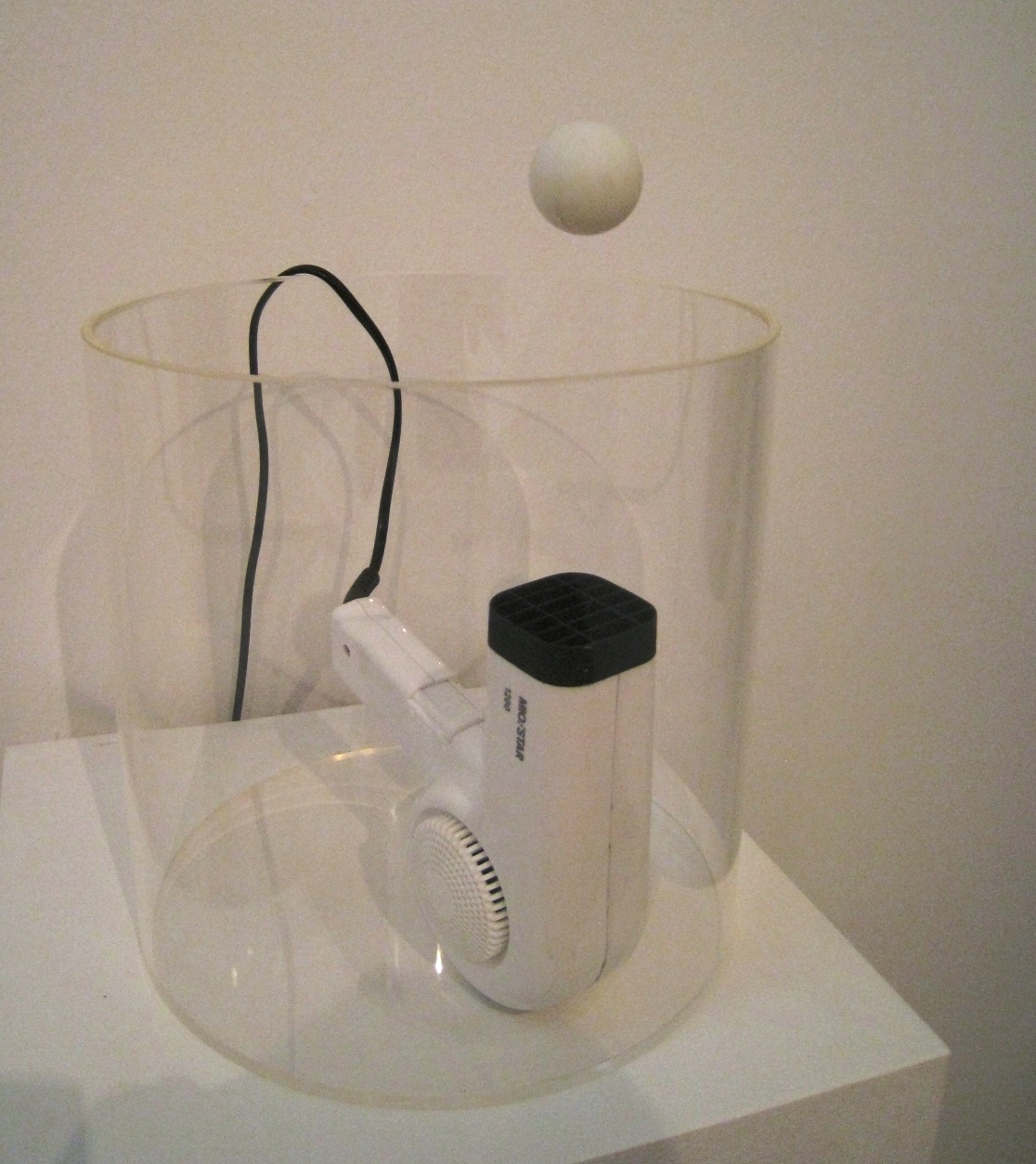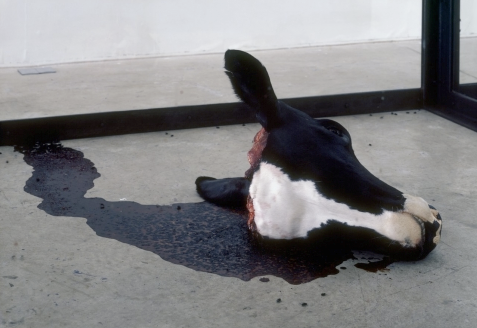Damien Hirst, Tate Modern | reviews, news & interviews
Damien Hirst, Tate Modern
Damien Hirst, Tate Modern
Beyond the media hoopla, the artist's retrospective isn't all smoke and mirrors

How long will it take for the penny to finally drop and to know we’ve been had all along? Months? Years? Ten years? Twenty? Will it really take that long before we come to our senses, and to wonder at our own gullibility? I’m talking not of Damien Hirst, who some now imagine has been conning us all for years, but of the execrable Lady Gaga. Yes, Gaga must be “exposed”! For is pap in pop really any lesser crime than art pap?
We don’t expect gallery artists to be like Lady Gaga, or The Spice Girls, though. Art is different: however “low” we’ve sought to take it, whatever demotic argot it strives to talk in, it’s still part of High Culture. And in High Culture the language of money is dirty, even though it was Warhol himself who celebrated the dollar sign, and even though art and money have always, always been co-dependents. But can you imagine a sanctimonious pundit-novelist condemning the pop industry in the same terms he condemns the art world, for selling works for a mint and for “artistes” making a mint and buying big country houses? Not really.
Each work is a powerful modern memento mori
But ever since public galleries have been dealing with living artists, the relationship between public art institutions and commerce has been naturally symbiotic. Of course. Art prices rise when the artist has the kudos of a major show. We don't begrudge Grayson Perry lining his pockets and securing his reputation with a British Museum show, no less, but it just seems that we simply cannot bear for Hirst to make any more money. Enough. Enough already.

So between the hype and the backlash – which is not only predictable and stupid in its polarised extremities but which Hirst has enjoyed simultaneously almost from the beginning of his career – what can we seriously say about Hirst’s first major retrospective? What can we say, other than it feels less like a mid-career survey and more like an obituary? Yes, we’ve come not to praise him but to bury him. We haven’t, after all, been expecting Hirst to do anything new or interesting for years, for his best years are far, far behind and he could have exited stage left in 1991 and we might still be talking about those early works: A Thousand Years, 1990 (detail pictured next page), the stinking double-vitrine containing a cow’s severed head in a pool of congealed blood, and the hatching and feasting flies and an electrocutor; the shark (The Physical Impossibility of Death in the Mind of Someone Living) just a year later, which now looks oddly small, like visiting your old primary school; and, to a lesser degree, The Acquired Inability to Escape, 1991, the glass cage that simply contains an office chair and desk, a packet of fags, an ashtray and a lighter (pictured above). Each work is a powerful modern memento mori.


There’s only one thing that arrests in that first room and that’s the black-and-white photo that Hirst posed for in an anatomy museum when he was 16. He is literally laughing in the face of death as he poses with the severed head of a fat man, who, in turn, looks rather like he’s in on the joke. Is it possible to taunt the dead?
There’s an undeniable strain of cruelty in Hirst that we never quite get away from, but which can, in fact, be stunningly effective, and I note that one work, which is both very cruel as well as crudely but genuinely, shockingly funny, is sadly missing: The Tranquillity of Solitude, 2006, which takes Francis Bacon’s triptych of George Dyer on a hotel toilet moments after he took an overdose and replicates it with three shorn sheep in separate vitrines. Instead, here are the sterile rows of cabinets containing prescription drugs, and a whole gallery of cold, stainless-steel medical implements, all neatly classified and presented as if healing and sadism are barely indistinguishable.
There’s beauty and bling aplenty. Beauty in the “stained-glass” cathedral triptych Doorways to the Kingdom of Heaven, 2007 (main picture), which is made up of thousands of luminous butterfly wings, and the rather more obviously macabre beauty of the “butterfly house” of In and Out of Love, 1991, where real butterflies – gorgeous giant ones – hatch, fly and die.
And then, in the last two rooms, there’s the "nasty bling" of the partial recreation of Hirst’s £111 million Sotherby’s job-lot of 2008, Beautiful Inside My Head Forever (including gold- and silver-framed glass shelves featuring row upon row of industrial diamonds), as well as, of course, the pièce de résistance, For the Love of God, 2007, the glinting, diamond-encrusted skull. The skull is presented in a walk-through big black box in the Turbine Hall. Entering it feels like entering a secret parlour at a Victorian freak show, and, in a way, what with all the media hoopla, this is exactly what this whole show feels like. Still, I’ll contend that not all of it is smoke and mirrors.
- Damien Hirst at Tate Modern until 9 September
rating
Share this article
Add comment
The future of Arts Journalism
You can stop theartsdesk.com closing!
We urgently need financing to survive. Our fundraising drive has thus far raised £49,000 but we need to reach £100,000 or we will be forced to close. Please contribute here: https://gofund.me/c3f6033d
And if you can forward this information to anyone who might assist, we’d be grateful.

Subscribe to theartsdesk.com
Thank you for continuing to read our work on theartsdesk.com. For unlimited access to every article in its entirety, including our archive of more than 15,000 pieces, we're asking for £5 per month or £40 per year. We feel it's a very good deal, and hope you do too.
To take a subscription now simply click here.
And if you're looking for that extra gift for a friend or family member, why not treat them to a theartsdesk.com gift subscription?
more Visual arts
 'We are bowled over!' Thank you for your messages of love and support
Much-appreciated words of commendation from readers and the cultural community
'We are bowled over!' Thank you for your messages of love and support
Much-appreciated words of commendation from readers and the cultural community
 Photo Oxford 2025 review - photography all over the town
At last, a UK festival that takes photography seriously
Photo Oxford 2025 review - photography all over the town
At last, a UK festival that takes photography seriously
![SEX MONEY RACE RELIGION [2016] by Gilbert and George. Installation shot of Gilbert & George 21ST CENTURY PICTURES Hayward Gallery](https://theartsdesk.com/sites/default/files/styles/thumbnail/public/mastimages/Gilbert%20%26%20George_%2021ST%20CENTURY%20PICTURES.%20SEX%20MONEY%20RACE%20RELIGION%20%5B2016%5D.%20Photo_%20Mark%20Blower.%20Courtesy%20of%20the%20Gilbert%20%26%20George%20and%20the%20Hayward%20Gallery._0.jpg?itok=7tVsLyR-) Gilbert & George, 21st Century Pictures, Hayward Gallery review - brash, bright and not so beautiful
The couple's coloured photomontages shout louder than ever, causing sensory overload
Gilbert & George, 21st Century Pictures, Hayward Gallery review - brash, bright and not so beautiful
The couple's coloured photomontages shout louder than ever, causing sensory overload
 Lee Miller, Tate Britain review - an extraordinary career that remains an enigma
Fashion photographer, artist or war reporter; will the real Lee Miller please step forward?
Lee Miller, Tate Britain review - an extraordinary career that remains an enigma
Fashion photographer, artist or war reporter; will the real Lee Miller please step forward?
 Kerry James Marshall: The Histories, Royal Academy review - a triumphant celebration of blackness
Room after room of glorious paintings
Kerry James Marshall: The Histories, Royal Academy review - a triumphant celebration of blackness
Room after room of glorious paintings
 Folkestone Triennial 2025 - landscape, seascape, art lovers' escape
Locally rooted festival brings home many but not all global concerns
Folkestone Triennial 2025 - landscape, seascape, art lovers' escape
Locally rooted festival brings home many but not all global concerns
 Sir Brian Clarke (1953-2025) - a personal tribute
Remembering an artist with a gift for the transcendent
Sir Brian Clarke (1953-2025) - a personal tribute
Remembering an artist with a gift for the transcendent
 Emily Kam Kngwarray, Tate Modern review - glimpses of another world
Pictures that are an affirmation of belonging
Emily Kam Kngwarray, Tate Modern review - glimpses of another world
Pictures that are an affirmation of belonging
 Kiefer / Van Gogh, Royal Academy review - a pairing of opposites
Small scale intensity meets large scale melodrama
Kiefer / Van Gogh, Royal Academy review - a pairing of opposites
Small scale intensity meets large scale melodrama
 Jenny Saville: The Anatomy of Painting, National Portrait Gallery review - a protégé losing her way
A brilliant painter in search of a worthwhile subject
Jenny Saville: The Anatomy of Painting, National Portrait Gallery review - a protégé losing her way
A brilliant painter in search of a worthwhile subject
 Abstract Erotic, Courtauld Gallery review - sculpture that is sensuous, funny and subversive
Testing the boundaries of good taste, and winning
Abstract Erotic, Courtauld Gallery review - sculpture that is sensuous, funny and subversive
Testing the boundaries of good taste, and winning
 Edward Burra, Tate Britain review - watercolour made mainstream
Social satire with a nasty bite
Edward Burra, Tate Britain review - watercolour made mainstream
Social satire with a nasty bite

Comments
Sounds like I'm no more
On the ground floor in the